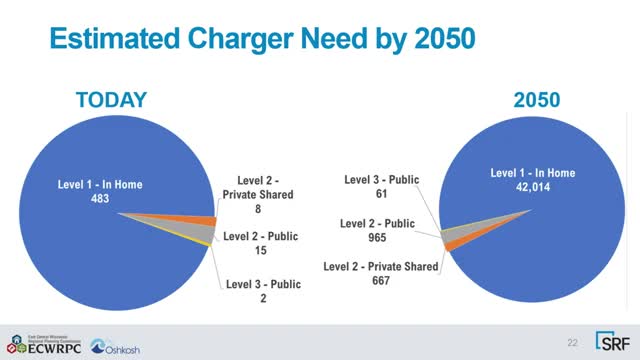City plans ambitious electric vehicle charging expansion
October 12, 2024 | Oshkosh City, Winnebago County, Wisconsin
This article was created by AI summarizing key points discussed. AI makes mistakes, so for full details and context, please refer to the video of the full meeting. Please report any errors so we can fix them. Report an error »

In a recent government meeting, officials discussed the future of electric vehicle (EV) charging infrastructure, emphasizing the predominance of home charging and the need for strategic public charging locations. The meeting highlighted that the majority of EV charging is expected to occur at home, primarily through Level 1 chargers, which are the most common type found in residential settings. As the number of electric vehicles in the region grows, officials anticipate that home charging will continue to dominate.
The discussion also addressed the importance of expanding Level 2 public charging stations, particularly in areas such as shopping centers, recreation facilities, and community centers. Officials noted that while Level 3 DC fast chargers are desirable, their implementation will be considered later as costs and availability become clearer. The plan aims to identify locations for Level 2 chargers, focusing on areas with high traffic and accessibility, including downtown public parking lots.
A significant aspect of the meeting was the consideration of equity in charging station placement. Officials acknowledged the need to address the charging needs of low-income communities, aiming to reduce greenhouse gas emissions and improve air quality in these areas. The plan includes analyzing zoning categories to identify suitable locations for charging stations, particularly in multifamily and office areas.
The meeting also covered the National Electric Vehicle Infrastructure (NEVI) Program, which will direct federal funds to construct and operate charging stations along interstate routes. Two locations in the region, including a Quick Trip in Oshkosh and a BP station in Neenah, have been approved for funding, each requiring the installation of four DC fast chargers.
For the pilot program, officials proposed two initial charging station locations: one near the convention center and another at Lakeshore Park. Each site would feature two charging devices with two ports to accommodate potential demand during events and peak usage times.
Overall, the meeting underscored a proactive approach to enhancing EV charging infrastructure, with a focus on home charging, public accessibility, and equitable distribution of resources to benefit all community members.
The discussion also addressed the importance of expanding Level 2 public charging stations, particularly in areas such as shopping centers, recreation facilities, and community centers. Officials noted that while Level 3 DC fast chargers are desirable, their implementation will be considered later as costs and availability become clearer. The plan aims to identify locations for Level 2 chargers, focusing on areas with high traffic and accessibility, including downtown public parking lots.
A significant aspect of the meeting was the consideration of equity in charging station placement. Officials acknowledged the need to address the charging needs of low-income communities, aiming to reduce greenhouse gas emissions and improve air quality in these areas. The plan includes analyzing zoning categories to identify suitable locations for charging stations, particularly in multifamily and office areas.
The meeting also covered the National Electric Vehicle Infrastructure (NEVI) Program, which will direct federal funds to construct and operate charging stations along interstate routes. Two locations in the region, including a Quick Trip in Oshkosh and a BP station in Neenah, have been approved for funding, each requiring the installation of four DC fast chargers.
For the pilot program, officials proposed two initial charging station locations: one near the convention center and another at Lakeshore Park. Each site would feature two charging devices with two ports to accommodate potential demand during events and peak usage times.
Overall, the meeting underscored a proactive approach to enhancing EV charging infrastructure, with a focus on home charging, public accessibility, and equitable distribution of resources to benefit all community members.
View full meeting
This article is based on a recent meeting—watch the full video and explore the complete transcript for deeper insights into the discussion.
View full meeting
